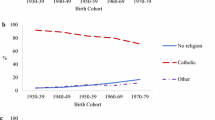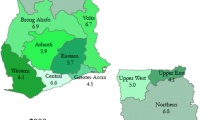Abstract
This paper examines religious group differences in fertility in developing nations. Using data from the Demographic and Health Surveys of 30 countries in Asia, Africa and Latin America, this paper documents Muslim/Christian and Catholic/Protestant differences in the number of children under age 5. The paper also considers possible explanations for these differences including level of development, religious mix, social characteristics and proximate determinants of fertility. Muslim fertility is substantially higher than Christian fertility in many countries, but the average difference between Catholics and Protestants is small. Cross-national variation in group differences is at least as large as the average difference. Although level of development, social characteristics and proximate determinants play an important role in religious differences, they do not explain cross-national variation in these differences.


Similar content being viewed by others
Notes
In a model that did not include an estimate of the variance in the coefficient for Christian, results were consistent with the interaction hypothesis. There are relatively few countries at the higher end of development so that it is difficult to estimate a variance component for Christian and the nonlinear relationship between development and the Christian/Muslim difference in fertility simultaneously.
References
Addai, I. (1999). Does religion matter in contraceptive use among Ghanaian women? Review of Religious Research, 40, 259–277.
Adsera, A. (2006). Religion and changes in family-size norms in developed countries. Review of Religious Research, 47, 271–286.
Agadjanian, V. (2001). Religion, social milieu, and the contraceptive revolution. Population Studies, 55, 135–148.
Akafuah, R. A., & Marie-Antoinette, S. (2008). Attitudes toward and use of knowledge about family planning among Ghanaian men. International Journal of Men’s Health, 7, 109–121.
Bongaarts, J. (1982). The fertility-inhibiting effects of the intermediate fertility variables. Studies in Family Planning, 13, 179–189.
Caldwell, J. C. (1980). Mass education as a determinant of the timing of fertility decline. Population and Development Review, 6, 225–255.
Chamie, J. (1981). Religion and fertility: Arab christian-muslim differentials. Cambridge: Cambridge University Press.
Davis, K., & Blake, J. (1955). Social structure and fertility: An analytic framework. Economic Development and Cultural Change, 4, 211–235.
Dharmalingam, A., & Philip Morgan, S. (2004). Pervasive Muslim-Hindu fertility differences in India. Demography, 41, 529–545.
Faust, K., Bach, R., Gadalla, S., Khattab, H., & Gulick, J. (1991). Mass education, Islamic revival, and the population problem in Egypt. Journal of Comparative Family Studies, 22, 329–341.
Frejka, T., & Charles, F. W. (2006). Religion, religiousness and fertility in the U.S. and in Europe. Max Planck Institute for Demographic Research Working Paper WP 2006-013.
Gaur, D. R., Goel, M. K., & Goel, M. (2008). Contraceptive practices and related factors among females in predominantly rural Muslim area of North India. Internet Journal of World Health & Societal Politics, 5, 3.
Goldscheider, C. (1971). Population modernization and social structure. Boston: Little-Brown.
Heaton, T. B. (1989). Religious influences on Mormon fertility. Review of Religious Research, 30, 401–412.
Heaton, T. B., James, S., & Oheneba-Sakyi, Y. (2009). Religion and socioeconomic attainment in Ghana. Review of Religious Research, 51, 71–86.
Hogan, D. P., & Biratu, B. (2004). Social identity and community effects on contraceptive use and intentions in Southern Ethiopia. Studies in Family Planning, 35, 79–90.
Hull, T. H. (2005). People, population and policy in Indonesia. Jakarta and Singapore: Equinox Publishing.
Iyer, S. (2002). Religion and the decision to use contraception in India. Journal for the Scientific Study of Religion, 41, 711–722.
Jones, G. W. (2006). A demographic perspective on the Muslim World. Journal of Population Research, 23, 243–265.
Knodel, J., Fray, R. S., Sricatcharin, P., & Peracca, S. (1999). Religion and reproduction: Muslims in Buddhist Thailand. Population Studies, 53, 149–164.
Lehrer, E. L. (2004). Religion as a determinant of economic and demographic behavior in the United States. Population and Development Review, 30, 707–726.
McQuillan, K. (2004). When does religion influence fertility? Population and Development Review, 30, 25–56.
Morgan, S. P., Stash, S., Mason, K. O., & Smith, H. L. (2002). Muslim and non-Muslim differences in female autonomy and fertility: Evidence from four Asian countries. Population and Development Review, 28, 515–538.
Mosher, W. D., & Hendershot, G. E. (1984). Religion and fertility: A replication. Demography, 21, 185–191.
Stark, R., & Iannaccone, L. R. (1994). A supply-side reinterpretation of the ‘Secularization’ of Europe. Journal for the Scientific Study of Religion, 33, 76–88.
Weeks, J. R. (1988). The demography of Islamic Nations. Population Bulletin. No. 43. Washington DC: Population Reference Bureau.
Westoff, C. F., & Jones, E. F. (1979). The end of Catholic fertility. Demography, 16, 209–217.
Zhang, L. (2008). Religious affiliation, religiosity, and male and female fertility. Demographic Research, 18, 234–257.
Author information
Authors and Affiliations
Corresponding author
Rights and permissions
About this article
Cite this article
Heaton, T.B. Does Religion Influence Fertility in Developing Countries. Popul Res Policy Rev 30, 449–465 (2011). https://doi.org/10.1007/s11113-010-9196-8
Received:
Accepted:
Published:
Issue Date:
DOI: https://doi.org/10.1007/s11113-010-9196-8




